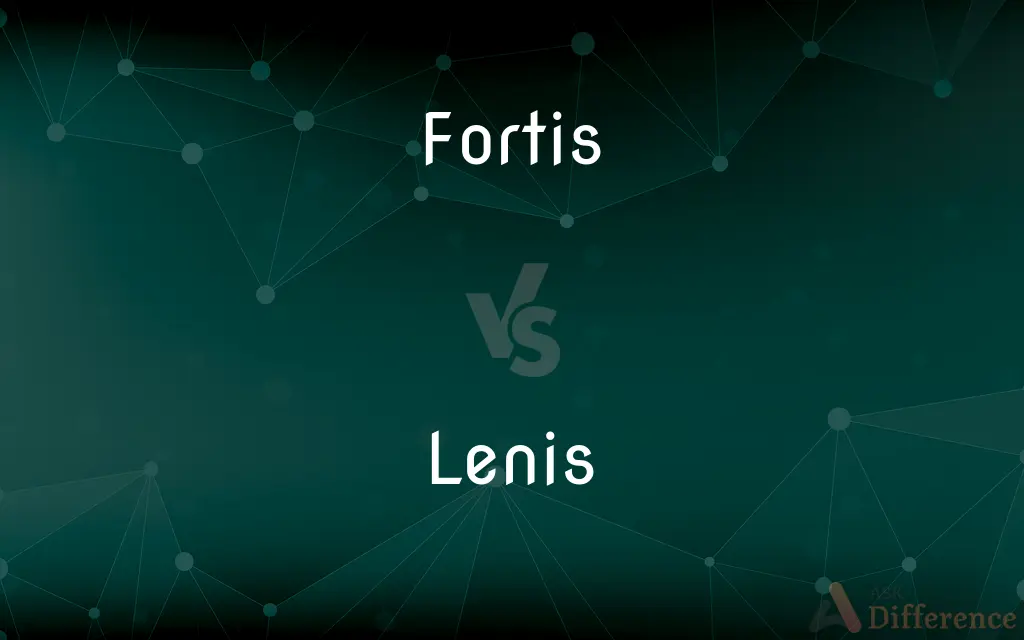Fortis vs. Lenis — What's the Difference?
By Tayyaba Rehman & Fiza Rafique — Updated on April 24, 2024
Fortis consonants are produced with greater muscular tension and are often voiceless, while lenis consonants involve less muscular tension and are frequently voiced.

Difference Between Fortis and Lenis
Table of Contents
ADVERTISEMENT
Key Differences
Fortis consonants are characterized by a stronger articulatory effort and longer duration, typically found in voiceless sounds like 'p', 't', and 'k'. Whereas, lenis consonants are articulated with less force and shorter duration, often corresponding to voiced sounds like 'b', 'd', and 'g'.
In many languages, fortis consonants are associated with aspirated or ejective articulations, which adds a burst of air or a glottalic effect. On the other hand, lenis consonants may feature partial voicing or no additional articulatory features, making them sound softer.
The fortis-lenis distinction can affect vowel length in some languages, where vowels before fortis consonants are shorter. Conversely, vowels before lenis consonants may be lengthened, influencing the rhythm and tempo of speech.
Fortis consonants usually resist voicing throughout their articulation, maintaining a clear, sharp sound. In contrast, lenis consonants can start off voiceless and become voiced, particularly in intervocalic positions, contributing to a smoother sound transition.
The perception of fortis and lenis can vary widely across languages, with some using the distinction to differentiate phonemic contrasts, while others may use pitch or tone instead of muscular tension.
ADVERTISEMENT
Comparison Chart
Muscular Tension
High
Low
Voice
Usually voiceless
Usually voiced
Duration
Longer
Shorter
Articulatory Features
Often aspirated or ejective
Often partially voiced
Effect on Vowels
May shorten preceding vowels
May lengthen preceding vowels
Compare with Definitions
Fortis
A consonant articulated with increased muscular tension.
The 'p' in pin is a fortis consonant.
Lenis
A consonant articulated with less muscular tension.
The 'b' in bin is a lenis consonant.
Fortis
Typically longer in duration than its lenis counterpart.
The 't' in tap lasts longer than in stab.
Lenis
Shorter in duration than its fortis counterpart.
The 'g' in log is quicker than the 'k' in lock.
Fortis
Often aspirated in languages like English.
The 'k' in kill is aspirated, making it fortis.
Lenis
Influences vowel length, typically lengthening them.
The vowel in bad is longer than in pat.
Fortis
Resistant to voicing throughout its articulation.
The 's' in sip remains voiceless.
Lenis
Can start off voiceless and become voiced.
The 'v' in view can begin less voiced in fast speech.
Fortis
Influences vowel length, typically shortening them.
The vowel in pack is shorter than in bag.
Lenis
Typically voiced in many languages.
The 'd' in dog is voiced, classifying it as lenis.
Fortis
Articulated with relatively strong pressure of the airstream below the glottis, as in English (p) and (t) compared with (b) and (d).
Lenis
Articulated with relatively low pressure of the airstream below the glottis, as English (b) and (d) compared with (p) and (t).
Fortis
A fortis consonant.
Lenis
(phonetics) Weakly articulated (of a consonant), hence voiced; especially as compared to the others of a group of homorganic consonants.
Fortis
(phonetics) Strongly articulated (of a consonant), hence voiceless.
Lenis
(phonetics) A lenis consonant.
Fortis
(phonetics) A fortis consonant.
Common Curiosities
Are fortis consonants always voiceless?
Mostly, but exceptions can occur depending on the language's phonetic rules.
Can the fortis-lenis distinction change across languages?
Yes, the application and perception of fortis and lenis can vary widely across different languages.
What are examples of languages using fortis and lenis distinctions?
English, German, and Korean, among others, use these distinctions to varying degrees.
What defines a lenis consonant?
Lenis consonants are marked by lower muscular tension and are usually voiced.
How do fortis and lenis consonants affect vowel length?
Fortis consonants typically shorten vowels, while lenis consonants may lengthen them.
Are there any common mistakes in identifying fortis and lenis consonants?
Misidentifying based on voicing alone can lead to errors, as other factors like duration and aspiration play roles.
What defines a fortis consonant?
Fortis consonants are marked by high muscular tension and are usually voiceless.
How do fortis and lenis consonants impact speech rhythm?
Fortis consonants can lead to choppier rhythms due to their longer duration, whereas lenis consonants contribute to smoother speech.
Can a consonant switch between fortis and lenis?
In some dialects and languages, yes, depending on contextual phonetic rules.
How is the fortis-lenis distinction taught in phonetics?
It is often introduced through examples and contrastive analysis between sounds.
Are lenis consonants always voiced?
Mostly, but there can be voiceless lenis consonants in certain phonetic environments.
Does the fortis-lenis distinction affect language acquisition?
Yes, it can influence how native and non-native speakers perceive and produce different sounds.
How can one practice distinguishing between fortis and lenis consonants?
Practicing pronunciation and listening to clear examples can help.
Is the fortis-lenis distinction the same as tense and lax?
While similar, tense and lax refer more broadly to vowel contrasts in some languages.
How do fortis and lenis characteristics manifest in whispered speech?
The distinction may be less clear, relying more on articulatory force than voicing.
Share Your Discovery

Previous Comparison
Dermatologist vs. Cosmetologist
Next Comparison
Iron vs. SilverAuthor Spotlight
Written by
Tayyaba RehmanTayyaba Rehman is a distinguished writer, currently serving as a primary contributor to askdifference.com. As a researcher in semantics and etymology, Tayyaba's passion for the complexity of languages and their distinctions has found a perfect home on the platform. Tayyaba delves into the intricacies of language, distinguishing between commonly confused words and phrases, thereby providing clarity for readers worldwide.
Co-written by
Fiza RafiqueFiza Rafique is a skilled content writer at AskDifference.com, where she meticulously refines and enhances written pieces. Drawing from her vast editorial expertise, Fiza ensures clarity, accuracy, and precision in every article. Passionate about language, she continually seeks to elevate the quality of content for readers worldwide.
















































